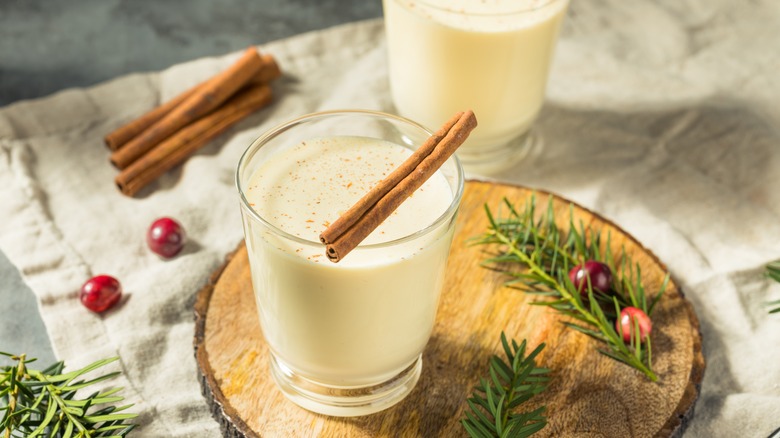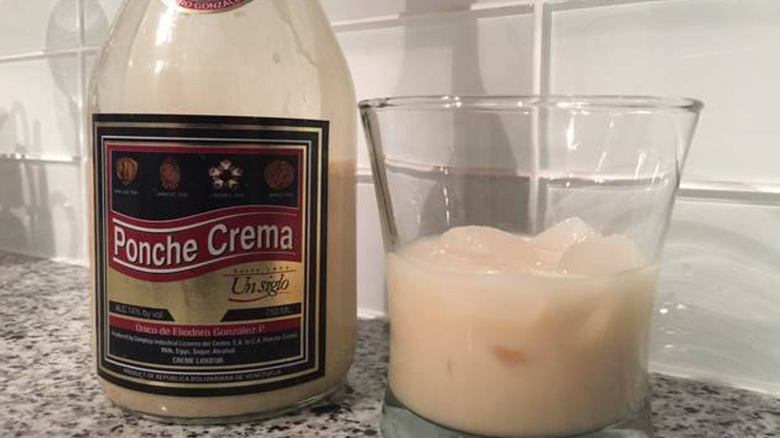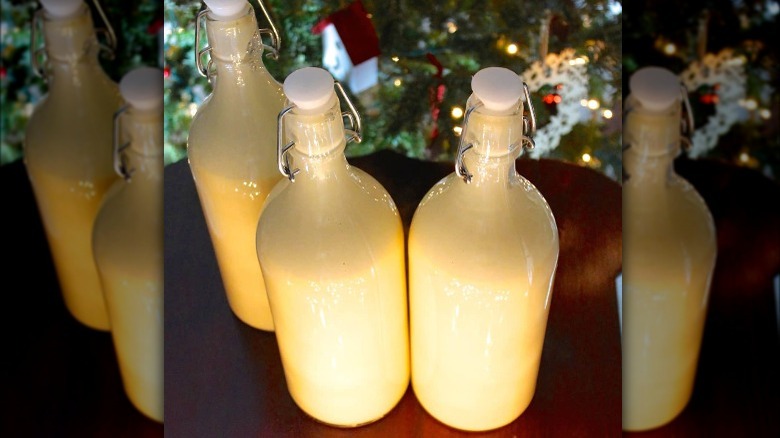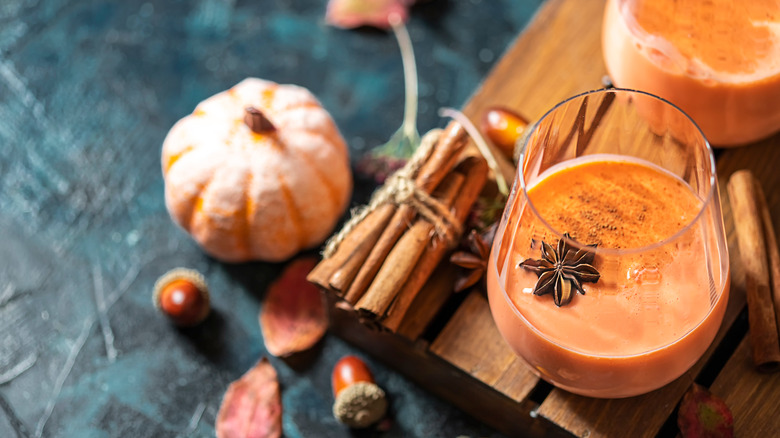Ponche Crema: The Venezuelan Eggnog With A Citrus Twist
Winter holidays are celebrated all the world over as a time of indulgence and festive gatherings, even if you happen to be in a place that doesn't ever see frosted windowpanes. Perhaps the single most decadent drink is eggnog, that rich concoction of eggs, cream, sugar, spices, and often the addition of a number of different kinds of booze. Historians agree that eggnog's roots are in medieval Britain, according to PBS, in a drink called a posset, a warm beverage made from curdled milk, with a variety of additions like eggs, wine, sherry, spices, brandy, and ale, enjoyed primarily by wealthy members of society because of the cost of the ingredients.
In the Americas, some of the ingredients for possets, like sherry and brandy, became even more expensive due to taxes levied by the British, according to Many Eats, though others, like fresh milk and eggs, along with American whiskey and Caribbean rum, became much more accessible to the masses.
Eggnog, as we know it, was born in the Americas, and it has variations throughout North, South, and Central America. Typically served chilled, these drinks have distinct regional variations. George Washington had his own seriously boozy eggnog recipe, made with brandy, rye whiskey, Jamaican rum, and sherry. Puerto Rico celebrates Christmas with coquito, eggnog made with the addition of cream of coconut, and in Venezuela, you'll find ponche crema, perhaps the most complex eggnog variation.
The history of ponche crema
In 1904, a chemist named Eliodoro González P. was granted a patent for a beverage called ponche crema, according to Complejo Licorera Ponche Crema. He was known to experiment with perfumes, but then he started to play around with mixing drinks using whatever was locally available. After some trial and error, he created a secret recipe that he found to be completely unique. It contained eggs, milk, sugar, alcohol, and unspecified spices. After he got his patent, González brought the drink to several competitions and it was especially popular at the 1904 World's Fair in St. Louis.
Of course, the fact that there was a commercially available ponche crema didn't stop Venezuelan families from experimenting to create their own versions of the holiday favorite. "Ponche," according to Dominican Cooking, simply means "punch," and "ponche crema" differentiates eggnog from the variety of fruit punches that you can find throughout the Caribbean and Latin America.
Ponche crema is widely acknowledged to have originated in Venezuela, but Trinidad and Tobago also claims the beverage, though they alter the name slightly to "ponche a crème" or "ponche de crème," (via Epicurious). Trinidad is now home to one of the important ingredients in classic ponche crema, a beverage that brings together both Venezuelan and Trinidadian roots.
How do you make ponche crema?
Venezuelan ponche crema calls for heating milk or cream, eggs, sugar, and spices — most often cinnamon, cloves, and nutmeg — along with lime or lemon zest, according to Tu Esquina Venezolana. After the spices have infused into the mixture, it's strained, rum is added, and it's chilled before serving. It's the brightness of the citrus zest that differentiates ponche crema from typical eggnog and the addition of an ingredient from Trinidad that perfects it.
Trinidad is home to the House of Angostura, the company famous for its bitters that can be found in practically every bar on the planet. Interestingly, though, the recipe for Angostura Bitters was perfected in 1824 by Dr. Johann Siegert, who lived in Angostura, Venezuela. The company moved its headquarters to Trinidad in 1875, where the bitters are produced to this day.
It's no surprise, then, that ponche de crème contains a few dashes of bitters, making the Venezuelan and Trinidadian eggnog even more complex. The aromatics of the bitters, coupled with the fresh citrus zest, add a depth of flavor and aroma not found in traditional American eggnog. Trinidad-born Brigid Washington, writing for Epicurious, pens a love letter: "Unlike eggnog, which can be cloying and one dimensional, ponche a crème has range ... The heady presence of lime zest and the orangey-botanical notes found in Angostura bitters joust with the buttery heft of the eggs. Nutmeg's warm and nutty sweetness leans into the drink's creaminess."
Variations of ponche crema
Some versions of ponche crema, like this one from Epicurious and a version from All Recipes, aren't cooked. Since consuming uncooked eggs can have some health risks, All Recipes suggests concerned cooks use a pasteurized egg product. Some ponche crema recipes use fresh cream or milk, and others use evaporated or sweetened condensed milk.
Simply Caribbean provides a variation of pumpkin ponche crema that's egg-free, and by using a vegan milk substitute like almond milk, oat milk, or soy milk, you can make an entirely plant-based ponche crema for your holiday celebrations. Mamás Latinas also has suggestions for playing with the flavors of your ponche crema to create a chocolate version, a coffee variation, one with dulce de leche, another with pistachio flavor, a coconut twist, a rum raisin version, and even a passionfruit ponche crema.
The flavors of classic ponche crema are perfect for family Christmas celebrations, and you can also make an alcohol-free version for children and non-drinkers. Keeping ponche crema in the refrigerator ensures you're ready for any winter holiday celebration.



